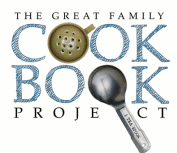Directions: |
Directions:Good equipment is important in candy making.
Use a large heavy aluminum pan to prevent candy from scorching, also to allow full rolling boil.
Use wooden spoons, paddles or pancake turners for stirring candy while cooking. They are easy to work with since handles do not become hot.
A good candy thermometer is important and will pay for itself if much candy is made. It is more reliable than the cold water test.
Use a pastry brush dipped in hot water to wash down crystals from sides of pan when candy starts to boil. This will help to keep candy from sugaring. This may be repeated 2 or 3 times during early stages of cooking candy. Change hot water for each washing down.
Marble slabs, platters or aluminum cookie sheets, are best to use for turning fondants and fudges out to cool before beating, also taffies before pulling.
Use only high grade ingredients. Do not substitute margarine or other fat for butter unless recipe so states.
Assemble all ingredients needed before starting. This will help to eliminate candy failures. Also cut nuts, etc. if needed in recipe.
Follow Directions The Quality of sugar is important. Cane Sugar will make a much smoother finished product. That is the only sugar I use in all my candies.
ALTITUDE CORRECTIONS:
Always test your thermometer before using in different altitudes.
Water boils at 212° at sea level. The recipe here are written for sea level. So if your thermometer boils below or above 212 °, you will need to add or subtract in the recipe.
COLD WATER TEST:
This test gives fairly good results. An experienced candy maker can get good results from it. Procedure for this method is: fill a cup with cold water and drop about 1/2 teaspoon of boiling mixture into the cold water. Shape the mixture with your fingers. Change the water after each testing.
Stages in the cold water test are: Soft Ball: (226° to 230°) at this stage the ball will tend to flatten out. Medium Soft Ball: (230° to 232°) a medium soft ball is one that begins to hold its shape. Firm Ball: (236° to 242°) this ball is relatively firm but is not hard. Hard Crack: (262º to 302 º) tap this ball against the side of the cup and it is brittle.
Some candies, if overcooked, may be revived by adding a small amount of milk, cream or water, depending on original recipe, and a little corn syrup and recooking.
Cream candies should be cooled to body temperature (so that it feels neither cool nor warm when touched gently by the finger tips) before beating begins. Beating the candy too soon will cause it to set up and become firm sooner, but it will have a coarser grain. Marble slab should be dampened with water or greased lightly with butter, depending on the recipe, before the candy is poured on it.
Method for beating fondants and other cream candies when marble slab and putty knives are used: With a putty knife (2 1/2 to 3 inches wide) in each hand, slide putty knife under the fondant and push it away from you, then turn putty knife over and bring it back over the top of the candy, spreading the candy as putty knife comes back. Then use other hand in same manner. Use the swing and weight of the body rather than just the arms. Use a smooth rhythmic movement. Alternate from right hand to left. Keep candy confined to small area on marble. Do not stop beating until the fondant sets up or candy will be coarse and grainy. This will take some time, so do not become discouraged and think candy has not been cooked long enough, When the fondant turns creamy, loses its gloss and becomes firm, knead for several minutes as you would knead bread dough. Flavorings can be added any time during the beating or before beating. Place fondant in a covered dish (Tupperware) or in a plastic bag to ripen and become mellow until time for dipping. Most cream candies are improved by allowing it to stand and mellow. I keep mine in a refrigerator as much as a week ahead before I dip them.
Caramels: Cut and dip.
Coconut Delight: Mold and dip and place almond on top.
Pin Wheels: Fondant and caramel layers rolled and cut and
dipped,
Nut Clusters: Plain roasted Spanish peanuts mixed with chocolate and dropped. |

 This recipe for General Suggestions For Candy Making is from
This recipe for General Suggestions For Candy Making is from